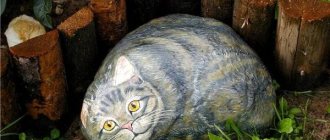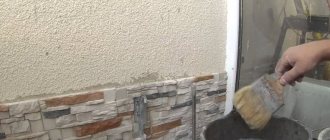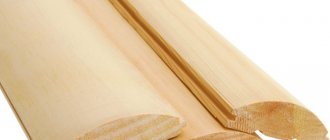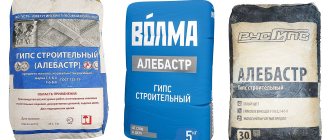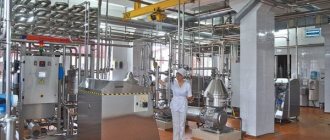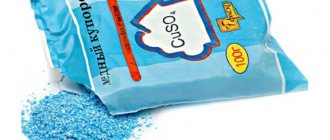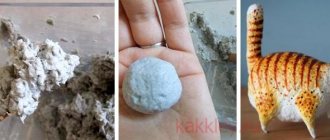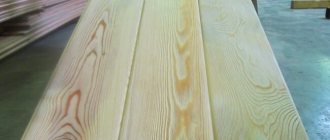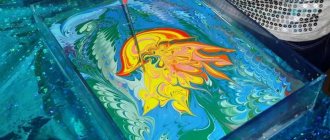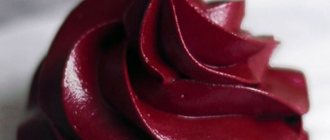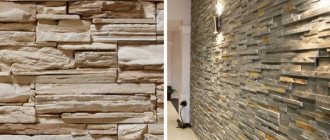For several thousand years, natural stones have been used to decorate buildings and structures. Today this is a fairly expensive material, but it has an alternative - making artificial stone with your own hands at home. If all actions are performed correctly, it will look attractive, and its cost will be significantly lower.
Using stone in interior decoration can achieve unexpected results. It is perfect for decorating the entire room or its individual elements, such as a fireplace and columns. Making artificial stone with your own hands is not difficult, but you need to correctly follow the entire sequence of procedures.
There is a similar article on this topic - Bath stones: which ones are better to choose?
In terms of mechanical resistance or other qualities, artificial stone is in no way inferior to natural stone. In addition, it has several important advantages:
- At home, artificial products can be made in thin tiles. This will reduce the weight of objects, but at the same time maintain strength;
- When working independently, it becomes possible to make a stone of the required shape for a specific place;
- Its production can occur at the point of use, so transportation waste is eliminated;
- It is possible to obtain a smooth stone. This eliminates polishing costs;
- Artificial stone at home can be created in irregular shapes. This allows you to imitate the household stone variety.
Main features of artificial stone
Various materials are used to make stone decor. Their choice depends on the place where the artificial stone will be used. Thus, indoor building structures are often finished with gypsum stone. Facades are usually faced with a material made from a cement mixture and various components.
Additives include materials that make it possible to obtain a relief pattern on the finished decor. For these purposes, stone chips, sand, fine gravel, and so on are used. In production, coloring pigments in dry and liquid states are also used. With their help, stone facing material of artificial origin is given the required shades.
Artificially formed stone decor is cast in special molds or made even without their use. This distinguishes it favorably from materials of natural origin. Professionals, strictly following production technology, create artificial stone with lumpy, smooth, layered, fine-grained and other textures.
Layered texture of artificially formed stone decor Source gesso3d.ru
Characteristics and properties of cement/concrete
There is probably no person who has not faced the need to use cement.
This is a truly universal material that is used everywhere. Not only is it convenient and easy to use, but it is also non-toxic, hypoallergenic and boasts a long service life. Even dentists initially used cement fillings. Cement is a powder made from clinker stone, which in nature and in industrial production is formed when clay and limestone are heated to 1.5 thousand degrees. The clinker granules are then mixed with other additives, such as gypsum, and ground to a powder. When interacting with water, cement forms stone. It is this quality that attracts builders and other lovers of working with stones.
The image shows cement
The most important criterion when choosing cement is its labeling. It is indicated by the letter “M” next to the number, which indicates the maximum weight that the finished product can withstand. Thus, M300 shows that with 300 kg of compression weight exerted on one cubic centimeter of this concrete, it can crack. If this indicator is 500, then you will have to apply 500 kg of pressure to destroy the stone.
Also next to the letter “M” is the letter “D”, which shows the percentage of additives in a given batch of cement. It is also possible to find abbreviations for properties that additives impart to cement, such as hydrophobicity, waterproofness, salt water resistance, white cement, or rapid-hardening.
The solution obtained from cement powder and water is called concrete. Therefore, in principle, buying concrete or cement means the same thing. When choosing cement, it is very important to look at the date of its production. Because despite all the advantages of this material, one of the main disadvantages is its short service life. Usually it is only 2 months from the date of manufacture. Thus, universal cement with a strength of M500 after 2 months will become as strong as M300, and after a while it will completely lose it. Therefore, try to purchase cement immediately before construction work and be sure to study the shelf life. What to do if you purchased good cement, but it’s a little stale? You can restore its strength by adding plasticizers to the mixture.
Advantages and disadvantages of artificially formed stone
Making decorative stone material is a creative work. For professionals with relevant experience, this is an easy process. At the same time, artificial stone has a number of other advantages:
- light weight, which is significantly less than that of a similar natural material, which allows for simpler transportation, processing, and installation;
- the ability to always produce additional volumes of products if there is a shortage of finished material for cladding specific structures;
- real quality control at every stage of production;
- possibility of casting directly at the site where installation is carried out;
- the presence of a smooth back surface, which makes decor installation easier;
- high fire resistance, allowing cladding of fireplaces, stoves and other similar devices;
- availability of components at low prices;
- variety of shapes, colors, sizes, textures.
Different colors and textures of artificial decorative stone Source vitrum-novo.ru
Before you make an artificial stone with your own hands, you definitely need to get acquainted with its disadvantages. Thus, some varieties of this material are manufactured exclusively using complex technologies. Organizing such production requires large financial costs.
Another disadvantage of artificially formed stone decor is that it is less durable than natural material. Although the service life can be 40 years if all rules for the care and maintenance of the lined surface are followed.
The benefits of making tiles yourself
Gypsum tiles can be used to finish:
- Slopes. After installing the windows, during repair work, the slopes on plasterboard windows are decorated with gypsum tiles.
- Fireplace. A plasterboard fireplace is covered with gypsum tiles to add naturalness and originality.Use of gypsum tiles
- A flight of plasterboard stairs is lined with gypsum tiles to create the interior of the house.
- Doorways are decorated with gypsum tiles.
- Walls in a room, in a living room, in a hall. Laying gypsum tiles under the brick, highlighting significant places, for example, the wall on which the TV is installed.
- Columns and niches made of plasterboard. Finishing occurs to accent the background of the overall interior.
Benefits of making tiles yourself:
- to make tiles you will not need a lot of space, as well as drywall tools;
- it is possible to produce tiles without using a vibrating table;
- The manufacturing technique is easy. It will be understood by a person making tiles for the first time;
- painting the tiles is done independently;
- All materials for tiles do not have a high cost, which makes the manufacturing process enjoyable.
Return to contents
Types of artificial stone
Only in accordance with the technology and with strict adherence to the recipe is it possible to obtain high-quality decorative building materials. Today, artificial stone is made using different methods. This allows you to obtain a material that differs in name and properties:
- Reinforced monumental stone made from concrete mortar.
It is produced individually by hand using free forming. Its production is carried out directly at the installation site. This technology allows you to create artificial boulders, granite slabs, and cobblestones.
Artificial boulder made of reinforced monumental stone Source baltiya-garden.ru
The mixture for materials is prepared on the basis of dry sand and cement. During its preparation, the components are mixed 1:3. At the same time, from 2% to 6% of pigment is also added. Its amount is calculated depending on the mass of the mixture. When preparing the solution, polymer-based additives are also used.
- Cement-sand molding stone material used during finishing and construction work.
Before you make a decorative stone with your own hands, you need to get acquainted with its properties. The material has increased resistance to low temperatures and excellent strength. The production of this type of stone can be carried out during the cold season. Typically, the manufacturing process is organized in workshops, garages and hangars.
- Artificial stone material based on gypsum.
Its casting is a simple technology that requires a minimum amount of equipment. Stone production is carried out in the warm season or in heated rooms. In this case, the material is used exclusively for internal cladding, as it is not resistant to temperature changes.
Artificial stone material made from gypsum Source prom.st
See also: Catalog of companies that specialize in finishing materials and related work
The mixture used is characterized by rapid hardening. Therefore, it is prepared in small portions, which are immediately poured into special matrices. Typically, no more than 4 minutes are spent on kneading and filling molds. In the production of such decorative stone, water is used, as well as citric acid to slow down the hardening process. Its amount is calculated depending on the weight of dry gypsum and is 1.3%.
Pigments are also used. Their amount is also calculated by the mass of gypsum and usually ranges from 2 to 6%. When selecting the optimal color option for the finished product, several samples are made, during the production of which different percentages of pigment are added to the mixture.
- Ceramic artificial stone is one of the most expensive facing stone materials.
Its production is carried out under exposure to high temperatures by firing or using the hardening method. The manufacturing process is always carried out in a heated room.
Ceramic stone in the bathroom Source pinimg.com
- Polyester decorative stone material obtained using synthetic substances.
Its production is carried out using hot hardening. Mineral fillers are used to make stone. During its production, a vacuum environment is created, which is required for curing the material. Therefore, production is carried out only in specially equipped workshops.
- Cast decorative stone made of acrylic, the production of which is characterized by cold hardening.
The material is produced using a vibration stand and strictly according to the instructions. Many of its properties are superior to those of other similar stones. In this case, it is possible to change the shape of the acrylic material when exposed to high temperatures and without loss of quality. Its maximum value is 210°C.
On a note! Decorative stone made of acrylic is characterized by the absence of pores and resistance to chemical reactions. It is able to provide a high level of hygiene. Therefore, it is often used in bathrooms, swimming pools, corridors, kitchen areas, terraces and verandas.
Decorative acrylic stone Source sense-life.com
- Liquid decorative stone material on gelcoat.
Its hardness is lower than that of cast stone. The reason for this is the smaller amount of mineral fillers used. Products of complex shapes are made from the mixture. In production, 2 types of composition are used. They differ in components and percentage of filler.
So, the primer composition of the gelcoat is 20%, and the front composition is 40%. The back compound is also used. It consists of a filler to which pigment is added in an amount of maximum 6%. The applied compounds set within 30 minutes, but decorative stones on the gelcoat are laid only after 24 hours.
Liquid stone product Source filigrano.by
Organization of the workroom
Before starting the production of decorative stone, you should properly plan the upcoming work and think through options for marketing the products.
The production of gypsum tiles at home and other facing stones in small quantities can be done in a small room - a personal garage or barn. If you want to organize an enterprise on a larger scale, you need to select a building of a larger size and taking into account certain requirements.
- Renting premises. It is more profitable to rent a work space on the outskirts of the city - it is easier to find a spacious and inexpensive building here. In addition, you will not have to deliver products from the center to customers.
- Water. The manufacture of artificial building material requires significant use of water. Therefore, you should rent a room near water wells or a water treatment plant. In such conditions, process water will be much cheaper when purchased, and its delivery to the place of stone production will cost minimally.
- Heating. Heating is not required for the warehouse space. If the finished product warehouse is located outside, it is necessary to make a rain shelter over it. The temperature of the main room reserved for the production of decorative stone must be positive so that the water necessary for work does not freeze. In a place specially designated for drying the stone, you must constantly maintain 30 degrees of heat and dry air. Rooms for auxiliary workers are also heated. We must not forget about ventilation in the room.
- Wiring. An important point is proper electrical wiring. When producing stone, a lot of electricity is consumed. Therefore, electrical wires must be in perfect condition and of the required size so that equipment breakdown or fire does not occur in this enterprise.
Faulty electrical wiring can lead to irreversible consequences
The production of stone in large quantities requires the recruitment of working personnel - at least two people: a technologist and an auxiliary worker.
Before starting a business, it should be registered with the relevant authorities.
Matrices for decorative stone material
There are different options for how to make a stone with your own hands. However, most of them are based on the use of special forms. Such matrices are available in different designs. There are more than a dozen varieties of them.
Different options for matrices for decorative stone Source twimg.com
Despite the large number of types of matrices, the following types of forms are most often used:
- Polyurethane matrices in finished form, used for the manufacture of small quantities of stones. They are durable and expensive
- Lost wax molds made of clay. They are used when applying wax. With their help, artistic casting and modeling are performed.
- Silicone matrices, which are used in small industries. Such forms allow the stone to be produced individually. Silicone matrices become deformed during operation. This allows you to make only about 10 castings.
Advice! Silicone matrices should be used on a sand bed. The reason for this is their change in shape when exposed to vibration and heat. Before casting begins, sand is poured into the pan, and then the matrix is deepened into it by a third of its height. In this case, be sure to check the horizontal position of the form using a level.
Basic properties, material classification
Decorative stone comes in two types - for interior and exterior use. For external stone, cement, sand and various pigments, dyes and other additives are used. The basis of the inner stone is gypsum. It is mixed with white cement, pozzolanic additions, oxide pigments, etc.
This connection produces a fairly strong material that:
- resistant to temperature changes;
- retains color when exposed to ultraviolet rays;
- hygienic;
- has low weight compared to natural stone;
- environmentally friendly;
- durable.
A simple way to make decorative stone
This option involves the production of artificial stone material by pouring 2 layers of the mixture into a mold. First, 3 parts of sand and 1 portion of cement are combined. Then the liquid dye is diluted with water. Its amount is usually approximately 2-3% by weight of cement. Then water with pigment is added to the cement-sand mixture until a homogeneous mass is formed, similar to thick sour cream.
The prepared solution is poured into the artificial stone matrix. It is only half full. Then the mixture is compacted and evenly distributed by shaking the mold and tapping, for example, on a table or other base on which the matrix is located.
A metal reinforcing mesh is laid on the first layer and the second part of the solution is poured, which must first be prepared without pigment. Then two lines are drawn crosswise on the surface of the mixture. They will improve the adhesion of the material during installation.
After about 12 hours, the hardened stone is removed from the matrix and dried. Then the mold is cleaned, washed and poured again.
Tools and stages of working with decorative concrete
In our case (an artificial boulder), for the upcoming work we will use a trowel, a brush with stiff bristles and a brush brush as tools (see the link at the end of the article).
Using a trowel, we alternately throw the prepared concrete mixture onto the surface of the block. Alternatively, it can be pre-mixed by making several turns with a spatula (as was done when making a vase for a fountain).
We vary the thickness of the layer, roughly forming the main outlines and shape of the stone.
Since the mixture is soft and plastic, like sculptural plasticine, using a trowel you can easily obtain any surface relief. When comparing with natural stone, you can take your time and calmly “draw” similar contours. Having finished, we slightly smooth out the unevenness with a trowel and lightly go over it with a brush with stiff bristles.
Making gypsum stone
In the production of decorative stone materials, building gypsum is often used. A mixture is prepared from it, the consistency of which should be similar to thick sour cream. When mixing, a pigment of the required color is also used.
The prepared mixture is poured into a silicone mold only up to half its height. The matrix is pre-lubricated with grease. Then a fine metal mesh is laid to enhance the strength of the stone. The mold is then filled to the brim with a mixture that lacks pigment.
The filled matrix is shaken several times so that the gypsum mixture is evenly distributed in the mold. If the curing process occurs quickly, then milk is used during mixing. It reduces the speed of setting of the mixture.
Finished stone decor
You can use paint on the outside of the stone, not just dyes.
Paint the product when it is dry. The surface is wiped from dust, then paint is applied. This must be done several times. More layers of paint will adhere more firmly.
You can apply a funny design as the last layer.
Photo from the site: https://diz-cafe.com
For interior decoration, gypsum stone is usually used. And for the outside - from cement. Additives to the cement mixture can include fine gravel, stone chips, and sea salt.
The silicone version of the mold is the most convenient.
Making decorative stone without using a mold
The production of artificial stone material is carried out not only using special matrices. It is also possible to make such decor without the help of molds. This option is very simple. Despite this, it allows you to produce original stones for cladding building structures in a private house.
Before you make an artificial stone without a shape with your own hands, you need to prepare a stencil. It is performed on ordinary oilcloth. Instead, a cardboard sheet of suitable size is often used. The dimensions of future stones are drawn on the selected material.
Although the entire process of making artificial stone decor is simple, it requires time and minimal experience in working with building materials. Therefore, it will be easier for many to purchase ready-made products and hire specialists to install them.
Decorative stone created without using a mold Source samsmogy-remont.ru
The process of manufacturing artificial stone decor is performed as follows:
- Construction plaster is mixed with water in a silicone container. Instead, you can use any container, inside of which a garbage bag is previously placed. Moreover, you can always throw it away after use.
- The stencil is protected with transparent oilcloth.
- The prepared mixture is distributed over the surface of the oilcloth within the boundaries indicated on the stencil.
- The drying gypsum mixture is given the required relief. To do this, use spatulas of different sizes.
- The drying gypsum mixture is divided into separate fragments in accordance with the markings on the stencil.
- The finished hardened tiles are removed from the oilcloth after about 15-20 minutes.
- Tiled decorative material is dried for 1 day.
How to make a mold
Before you start working on the stone itself, you need to make a mold for it. Although you don’t have to do this, but simply buy ready-made ones, making it yourself is not too difficult a task. The mold can belong to one of about a dozen varieties; the easiest one is to make a silicone one - it is the process of its manufacture that will be discussed further.
- First you need formwork. The material for it can be PVC panels, plastic containers and the like. Mark the template with a 1 cm allowance from the edges and cut it out.
- Prepare hot soapy water.
- Apply lubricant inside the formwork (you can use grease).
- Place the sample inside, having also lubricated it first.
- Squeeze out the silicone.
- Soak the brush in soapy water, coat the silicone and press it in, do not forget to constantly foam the water and dip the brush in it. Make sure there are no gaps between the silicone and the surface of the sample stone.
- When you're done with this, all that remains is to use a spatula, also previously soaked in soapy water, to level the surface with it.
The silicone will take a long time to dry: about a centimeter per week, so it’s best to start making molds well in advance. When it dries, the formwork will need to be disassembled and checked to see if there are any cracks. If they are found, cover them with fresh silicone. Using one matrix, you can make about a dozen stones, after which it becomes deformed - so you should immediately calculate how many forms you will need.
Area of use of decorative stone
Thanks to its significant advantages, artificial stone is an ideal finishing material. It is used indoors and on facades, depending on the manufacturing method. In addition, certain types of material are used to manufacture specific products. Let's take a closer look at what can be made from artificial stone:
- countertops for kitchen furniture, which are highly resistant to damage;
- bar counters that are durable;
- sinks and sinks that have an attractive appearance and original design;
- window sills of various sizes and shapes;
- coffee and dining tables;
- stylish and custom mirror frames;
- shelves in a variety of colors.
Stone shelves in the interior Source design-homes.ru
Decorative stone material is used to create wall panels, when cladding steps, railings, and arched structures. The use of artificial stone in the interior and when arranging a garden plot is an indicator of respectability and excellent taste.
Compound
It is clear that the main ingredient is Portland cement. Fillers can be various materials. It all depends on what properties the “master” wants to give to the final product. The choice is quite extensive, but we list the most common:
- Expanded perlite. Strengthens the anti-corrosion properties of products.
- Pumice. Significantly reduces the weight of artificial stone.
- Ceramic crumbs (small fractions).
- Expanded clay.
The last one is worth dwelling on in more detail. The properties of this material are well known. By adding it to the prepared composition, two problems are solved at once: the artificial stone turns out to be quite light and at the same time is characterized by minimal heat loss, which allows you to save on insulation materials.
In addition, depending on the conditions of further operation, various water repellents are introduced into the prepared composition, which strengthen the structure of the material (reinforcement) of the product.
Briefly about the main thing
Artificial stone is a material made from cement and sand. Gypsum is also used. The composition also includes water, dyes, and plasticizers. Ceramic, polyester, acrylic, reinforced and liquid stone on gelcoat are also produced. They are used to create shelves, sinks, furniture items, and boulders.
The material is lightweight, fireproof and affordable. It is made in different colors, shapes and textures. Its durability is less than that of natural stone.
During production, molds are used in which the mixture hardens. Coloring is done during the mixing process or after the tiles have dried. There is a manufacturing option using a lined stencil and without a mold.
Ratings 0
